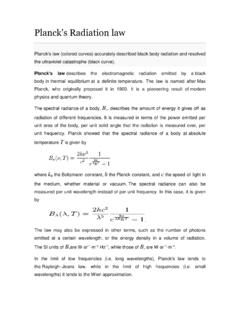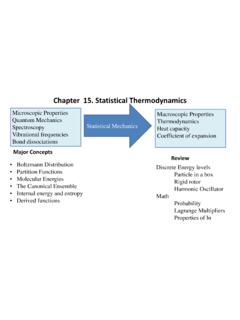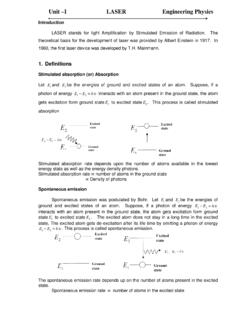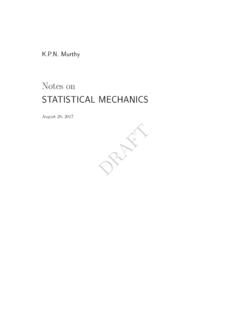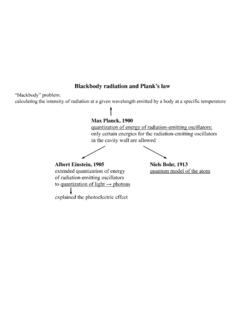Transcription of LECTURE 13 Maxwell–Boltzmann, Fermi, and Bose Statistics
1 LECTURE 13 maxwell boltzmann , Fermi, and Bose StatisticsSuppose we have a gas of N identical point particles in a box ofvolume V. When wesay gas , we mean that the particles are not interacting with one another. Suppose weknow the single particle states in this gas. We would like to know what are the possiblestates of the system as a whole. There are 3 possible cases. Which one is appropriatedepends on whether we use maxwell boltzmann , Fermi or Bose Statistics . Let s considera very simple case in which we have 2 particles in the box and the box has 2 singleparticle states. How many distinct ways can we put the particles into the 2 states? maxwell boltzmann Statistics : This is sometimes called the classical case.
2 In thiscase the particles are distinguishable so let s label them Aand B. Let s call the 2 singleparticle states 1 and 2. For maxwell boltzmann Statistics any number of particles canbe in any state. So let s enumerate the states of the system:Single Particle State 1 2--------------------------------------- --------------------------------ABABA BB AWe get a total of 4 states of the system as a whole. Half of the states have the particlesbunched in the same state and half have them in separate Einstein Statistics : This is a quantum mechanical case. This means that theparticles are indistinguishable. Both particles are labelled A. Recall that bosons haveinteger spin: 0, 1, 2, etc.
3 For Bose Statistics any number of particles can be in one let s again enumerate the states of the system:Single Particle State 1 2--------------------------------------- --------------------------------AAAAA AWe get a total of 3 states of the system as a whole. 2/3 of the states have the particlesbunched in the same state and 1/3 of the states have them in separate Statistics : This is another quantum mechanical case. Again the particles areindistinguishable. Both particles are labelled A. Recall that fermions have half integerspin: 1/2, 3/2, etc. According to the Pauli exclusion principle, no more than one particlecan be in any one single particle state. So let s again enumerate the states of the system:Single Particle State 1 2--------------------------------------- --------------------------------A AWe get a total of 1 state of the system as a whole.
4 None of the states have the particlesbunched up; the Pauli exclusion principle forbids that. 100% of the states have theparticles in separate simple example shows how the type of Statistics influences the possible states ofthe FunctionsWe can formalize this somewhat. We consider a gas ofNidentical particles in avolumeVin equilibrium at the temperatureT. We shall use the following notation: Label the possible quantum states of a single particle byrors. Denote the energy of a particle in staterby r. Denote the number of particles in staterbynr. Label the possible quantum states of the whole gas the particles in the gas are not interacting or are interacting weakly, we can describethe stateRof the system as havingn1particles in stater= 1,n2particles in stater= 2,etc.
5 The total energy of the state isER=n1 1+n2 2+n3 r(1)Since the total number of particles isN, then we must haveXrnr=N(2)The partition function is given byZ=XRe ER=XRe (n1 1+n2 2+..)(3)Here the sum is over all the possible statesRof the whole gas, , essentially over allthe various possible values of the numbersn1,n2,n3, ..Now we want to find the mean numbernsof particles in a states. SincePR=e (n1 1+n2 2+..)Z(4)is the probability of finding the gas in a particular state where there aren1particles instate 1,n2particles in state 2, etc., one can write for the mean number of particles in astates:ns=XRnsPR=PRnse (n1 1+n2 2+..)Z(5)2We can rewrite this asns=1 ZXR 1 s!e (n1 1+n2 2+..)= 1 Z Z s(6)orns= 1 lnZ s(7)So to calculate the mean number of particles in a given single particle states, we justhave to calculate the partition functionZand take the appropriate derivative.
6 We wantto calculatensfor maxwell boltzmann , Bose and Fermi boltzmann StatisticsLet us begin by considering the classical case of maxwell boltzmann Statistics . Inthis case the particles are distinguishable but identical,so each particle has the same setof single particle energy levels. As a result we can write the partition function asZ= N(8)where the single particle partition function is =Xre r(9)ThenlnZ=Nln =Nln Xre r!(10)Now we can calculate the mean occupation numberns= 1 lnZ s= 1 N e sPre r(11)orns=Ne sPre r(12)This is called the maxwell boltzmann distribution . It isthe same as our previousresult when we applied the canonical distribution toNindependent single particles in aclassical system.
7 The sum overris a sum over single particle Derivation of maxwell boltzmann Partition FunctionWe can write thepartition function of the gas asZ=XRe (n1 1+n2 2+..)(13)Here we are summing over all possible statesRof the gas, , over all valuesnr= 0,1,2,3, ..for eachr(14)3subject to the restrictionXrnr=N(15)Since this is a classical system, the particles have to be considered distinguishable. Thusany permutation of two particles in different states must be counted as a distinct stateof the whole gas even though the numbersn1, n2, n3, ..are left unchanged. This was thecase in our simple example. It is not enough to specify how many particles are in eachsingle particle state, but it is necessary to specify whichparticular particle is in whichstate.
8 For a given set of valuesn1, n2, n3, .., there areN!n1!n2!..(16)possible ways in which the particles can be put into the givensingle particle states withn1particles in state 1,n2particles in state 2, etc. This is the number of distinct statessince the particles are distinguishable. HenceZ=Xn1,n2,..N!n1!n2!..e (n1 1+n2 2+..)=Xn1,n2,..N!n1!n2!.. e 1 n1 e 2 (17)Because of (15), this last expression is just a multinomial expansion. So we can writeZ= e 1+e 2+.. N(18)orlnZ=Nln Xre r!(19)wherePre ris just the partition function for a single particle. This iswhat we Einstein and Photon StatisticsHere the particles are to be considered as indistinguishable, so that the state of thegas can be specified by merely listing the number of particlesin each single particle state:n1,n2,n3.
9 Since there is no limit to the number of particles that can occupy a state,nscan equal 0,1,2,3,.. for each states. For photons the total number of particles isnot fixed since photons can readily be emitted or absorbed by the walls of the s calculatensfor the case of photon Statistics . The partition function isgiven byZ=XRe (n1 1+n2 2+..)(20)where the summation is over all valuesnr= 0,1,2,3, ..for eachr, without any furtherrestriction. We can rewrite (20) asZ=Xn1,n2,..e n1 1e n2 2e n3 (21)4orZ= Xn1=0e n1 1 Xn2=0e n2 2 Xn3=0e n3 3 ..(22)But each sum is a geometric series whose first term is 1 and where the ratio betweensuccessive terms is exp( r). Thus it can be easily summed: Xns=0e ns s= 1 +e s+e 2 s+.
10 =11 e s(23)Hence eq. (22) becomesZ= 11 e 1 11 e 2 11 e 3 ..(24)orlnZ= Xsln 1 e s (25)So if we plug this into eqn. (7), we getns= 1 lnZ s=1 sln 1 e s =e s1 e s(26)orns=1e s 1(27)This is called the Planck distribution . We ll come back tothis a bit later when we talkabout black body are bosons, but their total number is not conserved because they can beabsorbed and emitted. Other types of bosons, however, do have their total numberconserved. One example is4He atoms. A4He atom is a boson because if you add thespin of the proton, neutron, and 2 electrons, you always willget an integer. If the numberof bosons is conserved, thennsmust satisfy the conditionXsns=N(28)whereNis the total number of bosons in the system.




